Content duplication and keyword cannibalization are costly — but common — SEO issues. In this session, our experts help SEO pros and website teams combat these “dupes and cannibals” to improve their organic search results.
Featured speakers:
- Richard Barrett, Director of SEO Professional Services at Lumar
- Jon Earnshaw, Chief Product Evangelist at Pi Datametrics
- Matt Hill, SEO Solutions Consultant at Lumar
Watch the full SEO webinar — including Q&A session — above, or read on for our key takeaways.
In this webinar, we cover:
- How does keyword cannibalization negatively impact your SEO efforts?
- What are the main causes of keyword cannibalization?
- Why is it a problem?
- How can you identify cannibalization on your site?
- How to fix the issues caused by conflicting keyword cannibalization
- How to monitor cannibalization
Let’s dive in…
What is keyword cannibalization?
In SEO, keyword cannibalization occurs when multiple pages on a website target the same keywords or keyphrases, causing them to compete against each other in search engine results. This can confuse search engines about which page to rank for that particular keyword, potentially leading to a decrease in overall search visibility and traffic for the website.
“Cannibalization is not a content thing,” says Jon Earnshaw of Pi Datametrics, “It’s a keyword thing.”
“You can have 3 pieces of content that appear to be in conflict — or suffering from cannibalizations [in the SERPs] — for 1 or 2 keywords, but not that many other keywords.”
“There’s almost an extra complexity as a result of that, where you can be thinking about, ‘how do I resolve this conflict between these 2 keywords’ — but then there are other keywords that you don’t want to affect,” adds Lumar’s SEO leader, Richard Barrett.
Earnshaw recommends that SEOs not rush into keyword cannibalization fixes or simply delete content entirely, as you’ll also need to consider what other keywords a given page might be ranking for that aren’t in conflict.
What are the main causes of keyword cannibalization?
Earnshaw and Barrett highlight five main causes of keyword cannibalization:
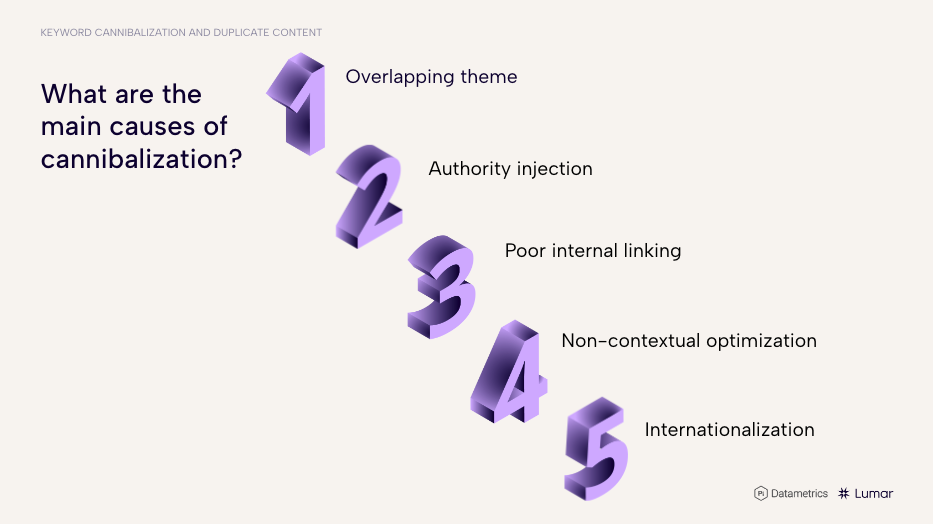
1. Overlapping theme
When the general ‘theme’ or topic of a page appears too similar to another page on your site, search engine bots may struggle to understand which page to index and rank.
Title tags, H1s, and URLs are key signposts to Google that tell the search engine what a web page is about.
“Google’s simply not sure which page to return for a particular keyword or string if page titles are too similar,” says Earnshaw.
Another way to identify overlapping themes in your content is to examine the page intent.
“If pages are serving the same intent in 2 instances, you’ve probably got an overlapping theme there,” explains Barrett. There’s a good chance that, where you’ve got an overlapping theme across multiple pages, you’ll run into keyword cannibalization issues.
2. Authority injection
When one page suddenly gets an injection of “authority” — generally in the form of increases in internal links or backlinks — it can cannibalize an existing page that was previously ranking well in the SERPs.
Earnshaw gives the example of an HSBC landing page that was previously ranking well for keywords relating to “best banks”. This page dropped suddenly in the SERPs after another HSBC content piece — a PDF that detailed the best bank accounts for students — received a sudden authority injection from universities in the UK linking to it, cannibalizing the position of the core landing page and causing it not only to drop off page one, but fall down 90 positions.
Barrett points to how this is a common occurrence in e-commerce SEO as well. For instance, when a new product is added with a subtle difference to an existing one – perhaps it’s a different color – but is being promoted as a Black Friday deal. Suddenly that page has become more authoritative and is now cannibalizing the original optimized page.
“The power of PageRank and the challenge of faceted search, those two combine there,” said Earnshaw of the e-commerce example.
3. Poor internal linking
Earnshaw reminds us that internal linking is fundamentally critical to good visibility in the SERPs. But if you’re not careful with the anchor text you’re using in your internal links, you might be sending mixed messages to Google regarding what those destination pages are all about.
Barrett points out how there is an opportunity here for SEOs to link back from newer pages to key conversion pages.
“You see it all the time, a new page comes out, but it starts pulling traffic away from where you want it to be,” he says. Linking from the new page back to the landing page where you want more visitors to land can help.
“It’s an absolute classic and so easy to fix,” Earnshaw adds.
4. Non-contextual keyword optimization
“Contextual optimization is where you stop and think before you publish. Where you ask the question, ‘what content in my ecosystem is complementary and can get links from [the proposed new piece of content] and what content in my ecosystem that is already there — that might have been there for years — is potentially conflicting as an overlapping theme or has a title that’s too similar?’” explains Earnshaw.
Before creating new content, SEOs need to think about what pages already exist on their sites relating to this topic or niche.
“If you just inject content into your ecosystem because somebody’s told you that Google loves fresh content, that is not contextual optimization and that can lead to huge cannibalization,” Earnshaw warns.
Barrett points to a common problem where sites start featuring things like latest news. “You might create gaps that Google needs to fill,” he says. “But you need to be filling these gaps.”
5. SEO internationalization
According to Barrett, localization is very important in creating a good user experience on the web. But creating multiple international versions of your website content can also lead to cannibalization issues if you don’t have strong international SEO strategies in place.
“The problem emerges when these pages are very similar,” he says.
He gives the example of sites with separate pages for US or UK audiences. These pages may show prices in different currencies, but with the same language in place on both pages, search engines may rank the wrong page in a given geography.
“Suddenly you get the US page appearing for the UK [search results], UK pages appearing for US people, and that’s less useful. And it’s reflected in the rankings.”
Why is keyword cannibalization a problem for SEO?
Keyword cannibalization is a problem simply because it can affect a company’s revenue, according to Earnshaw. Visibility in search engine results can drive more customers to buy from a business, and when pages are suppressed in the SERPs due to keyword cannibalization, that’s potentially impacting the company’s ability to drive sales.
In doing research into revenue potential as it relates to search visibility for an e-commerce website, Earnshaw found that about 40% of the search visibility struggles for one large department store were due to cannibalization issues.
Keyword Cannibalization Example: International Sites
Barrett digs a little deeper into the effect of keyword cannibalization on visibility in the SERPs when dealing with content across international domains.

In his first example, he found that almost 5% of the time US customers were being served the UK webpage in Google SERPs.
In the Geography 2 example, US contextual elements (such as dollar signs instead of pound) are being served to UK searchers.
The result, here, is that they are skipping over that result with mismatched contextual elements.
“You get a lower click-through rate (CTR) despite a higher position,” Barrett says.
Geography 3 shows US and Canada results for a Canadian-based search. Here, the US page is outranking the localized version and the CTR of the US page is very high. This raises the question of whether it’s worth optimizing this localized version of this page in the first place.
Keyword Cannibalization Example: Ecommerce
Earnshaw points to a keyword cannibalization issue he noticed with bestbuy.com when he recently searched “best Chromebook”. He saw that their visibility in the SERPs was fluctuating wildly when he carried out the same search on different days.
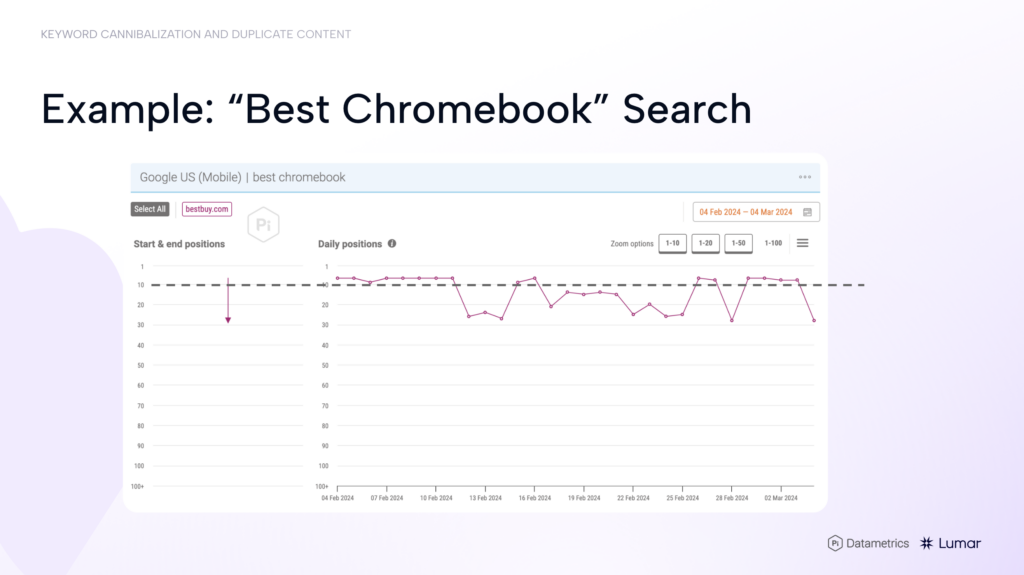
He noticed that Best Buy was only showing up in the search results 50% of the time.
“A 50% chance of actually landing on their site,” Earnshaw says, “When you’ve already got conversion rates at like, a low 2%… that’s not going to help you.”
The reason? Earnshaw found three very similar product pages that are sending confusing messages to Google. And none of these are the optimized category page that they likely want to appear.
These product pages have more authority and are all competing among themselves. As Earnshaw says: “The whole domain loses out.”
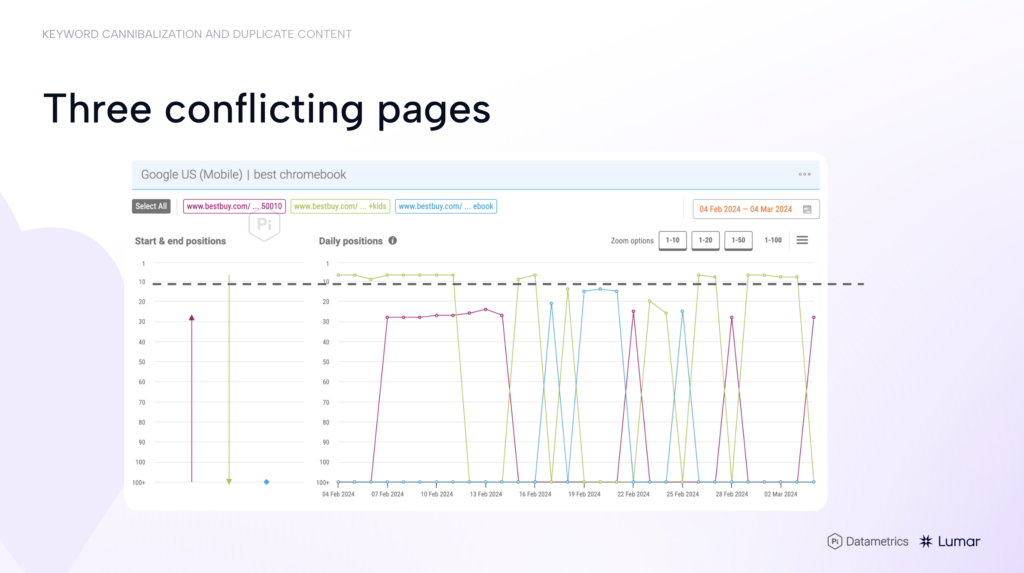
How to identify keyword cannibalization and duplicate content on your website
Barrett shows how we can use Lumar’s technical SEO platform to crawl a website and find out how many pages feature the exact same title as another page. (Remember the “overlapping theme” factor in cannibalization discussed above!)
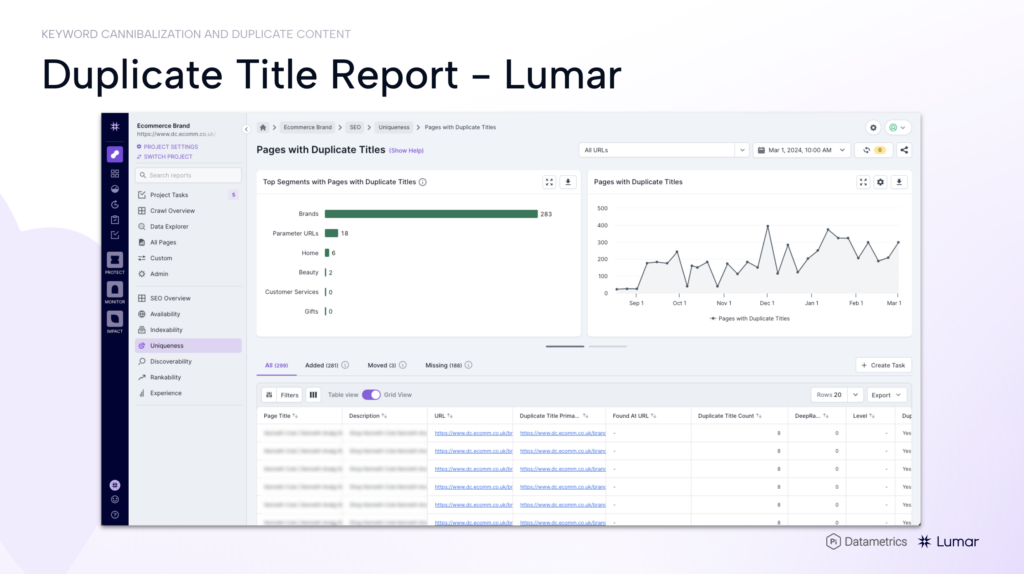
This is a great starting point for spotting cannibalization, as well as pointing to opportunities to appear in searches for other keywords.
Lumar offers 20 different metrics relating to page uniqueness and duplicate content including reports on:
- Duplicate pages
- Duplicate page sets
- Pages with duplicate titles
- Pages with duplicate body
- Duplicate URLs
- True uniques
- (and many more)
So you can make sure the technical foundations of your website content are poised to help you combat keyword cannibalization and rank well in search.
How to fix keyword cannibalization issues on your website
For Earnshaw, the first thing SEOs need to do when facing keyword cannibalization issues is to make a decision:
Do you want to be on page one for that keyword?
“If the answer’s yes,” he says, “Then you have to decide on which page you want to be the doorway into your ecosystem.”
Earnshaw uses the example of men’s blazers. He points to how all of the subcategory pages on an e-commerce site relating to different types of blazers may compete for the “men’s blazers” keyphrase in search engine results pages.

But before any changes are made to these pages, we need to see how visible each of these pages is in its own right.
“Before we start tampering with the linen blazers page – does it actually position well for linen blazers? And are we going to risk messing with that?” Earnshaw asks.
“Before you think, ‘oh, I’m cannibalizing for this keyword, let me change all of these pages’ — Check for visibility first! Be aware of your visibility outside [of any one specific keyword].”
“That’s why using Pi Datametrics is really good. Because it will monitor your visibility for every term you put into it,” says Earnshaw.
Once you’ve got the full picture of what other terms the competing pages are ranking for and which of those phrases you want to carefully maintain, you can begin to implement fixes for keyword cannibalization.
The Keyword Cannibalization Toolkit
Earnshaw offers a toolkit of potential fixes to address keyword cannibalization and duplicate content issues on your website.
Potential fixes for your keyword cannibalization issues include:
- Downgrade theming on the competing pages
- Merge and 301
- 301 older content to chosen doorway
- Link
- Noindex / archive
- Make a hub page
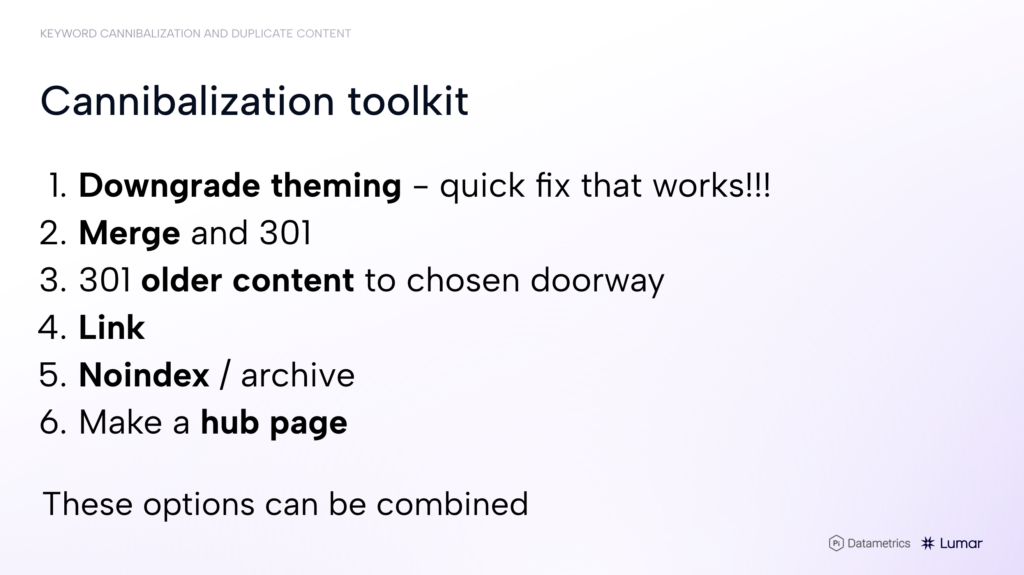
Downgrade theming on the competing pages
Using the same “men’s blazers” example from above, Earnshaw describes how to downgrade theming on competing pages:
“If we assume that the current title is ‘Men’s Summer Blazers’ we might want to refine that title to something like ‘Summer Blazers for the Stylish Man’,” says Earnshaw. This can help avoid a more direct title duplication with the “Men’s Blazers” page while retaining “Summer Blazers” as a longer-tail keyword on the page.
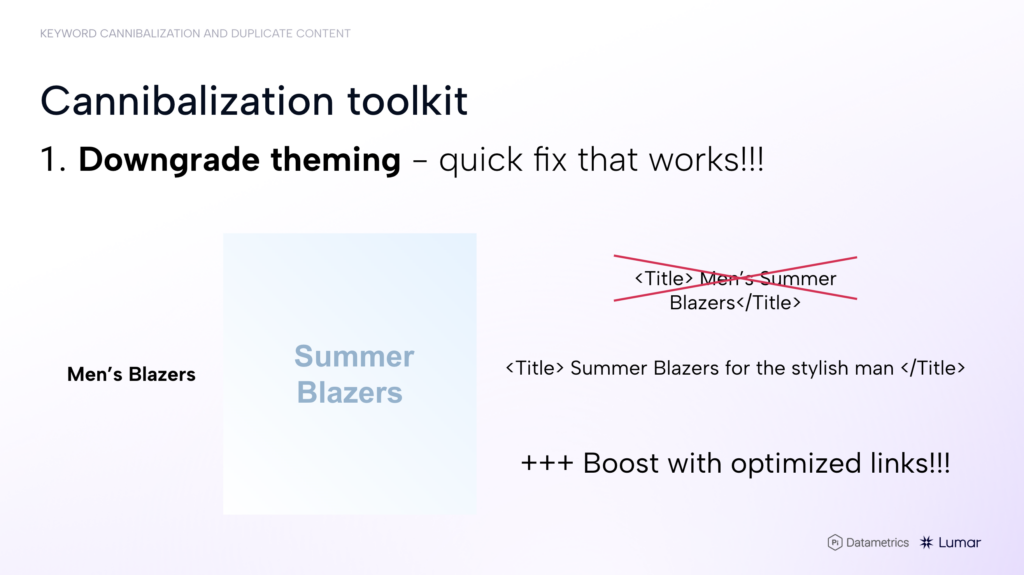
Merge pages and use a 301 redirect
Another option to address keyword cannibalization across these three pages could be to merge the content from the three pages onto one page and use a 301 redirect to point from the two discarded page URLs to the new merged content page.
Use a 301 redirect on older content
If you have older content on a similar topic, you could also 301 redirect the older pages to the new chosen doorway to boost its authority in the eyes of search engines.
Other tips for combatting keyword cannibalization on your website include optimizing your internal linking structures or using noindex directives to effectively archive the pages you don’t want search engines to index or rank.
Making a hub page
Earnshaw’s final suggestion is to make a new hub page that directly targets the keyword that’s currently being cannibalized across multiple pages. It can then ‘house’ the other 3 pages, which, in our example, provide more long-tail subcategories of the primary keyword topic they are all fighting for.
Using the men’s blazers example — if the 3 competing pages are focused on:
- Men’s Linen Blazers
- Men’s Summer Blazers
- Men’s Cotton Blazers
And all three are also competing to rank for the more straightforward “men’s blazer” keyword — then create a hub page that contains links to all three of the subcategory pages and stands a better chance of ranking for the core “men’s blazer” search term.
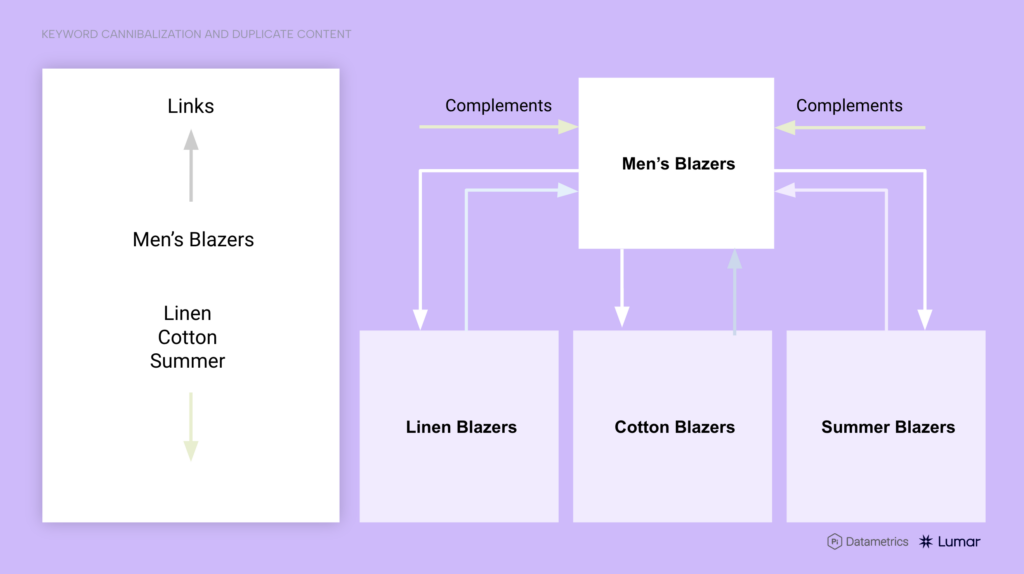
“Link to ‘summer’, link to ‘cotton’, link to ‘linen’, and get horizontal links as well,” suggests Earnshaw.
He suggests using the site operator in Google (ie, searching “site: www.nameofsite.com keyword”) to find complementary pages on your website that you can then link to from your new hub page.
Barrett agrees with Earnshaw that creating hub pages can be a very useful way to combat keyword cannibalization issues.
“It concentrates the authority to a single place,” Barrett says. “Sometimes it needs a bit of love and work initially, because you may have already successfully ranked with one page and/or several pages…but you’ve got more potential with where that could go for the core keywords on it.”
Finding relevant pages to link to with Pi Datametrics
Keyword- and content-focused SEO platforms and tools can also help you conduct this sort of research for keywords and internal linking.
“If you’re a Pi Datametrics user, brace yourselves — things are about to get super exciting because we are about to inject something incredible into the platform to do all of this for you,” Earnshaw announces.
“It will actually analyze your existing content to find pages where there are no links, semantically relevant ones, and then it will identify pages where the links are suboptimal.”
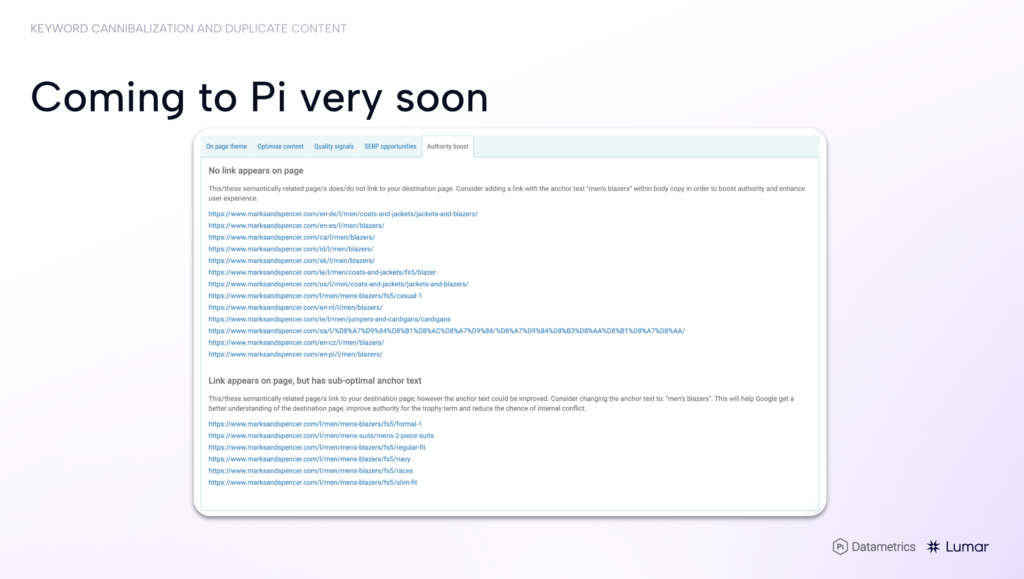
Identifying duplicate website content with Lumar
In Lumar, users can easily find duplicate content issues through both the technical SEO platform’s built-in technical SEO metrics and can get even more granular with the website data they examine by setting up custom extractions within the website crawler.
The tool can help us match up text or features that appear as duplicates on multiple pages and may be causing cannibalization problems for your SEO efforts.
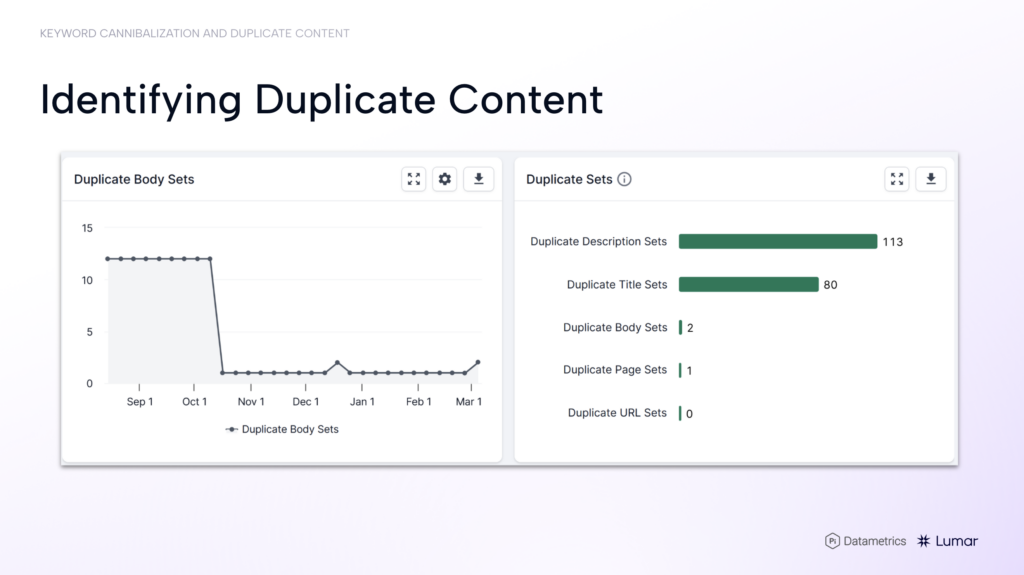
Monitoring keyword cannibalization
Beyond identifying existing cannibalization issues and making the necessary changes, SEO tools such as Lumar and Pi Datametrics help website professionals track and monitor their sites for new keyword cannibalization and duplicate content issues that might crop up in the future. This is particularly important for SEO on large enterprise websites and SEO on news websites where new content is published daily.
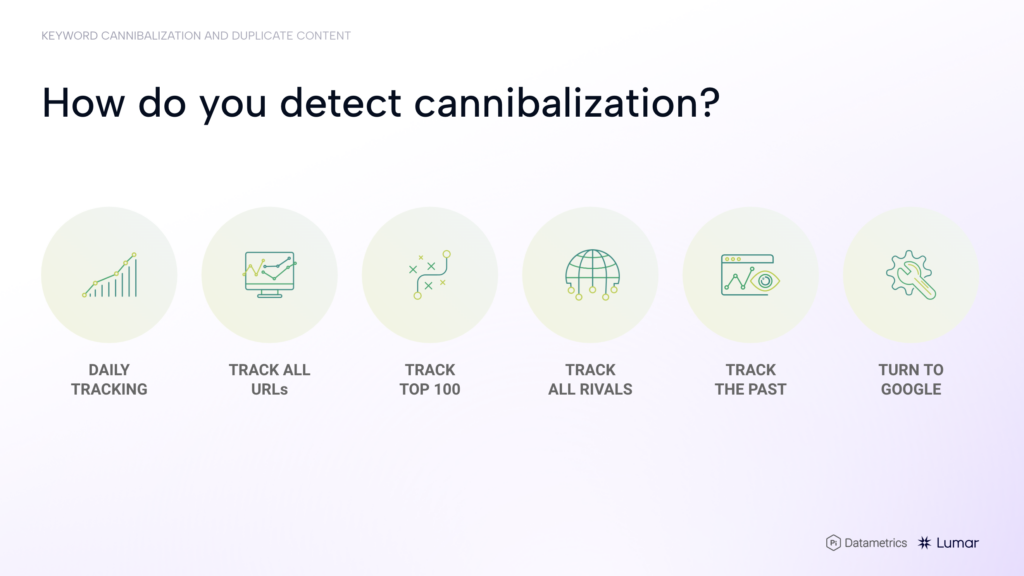
Having the right tech in place is crucial for catching any future issues early and, in the best cases, preventing keyword cannibalization before it happens.
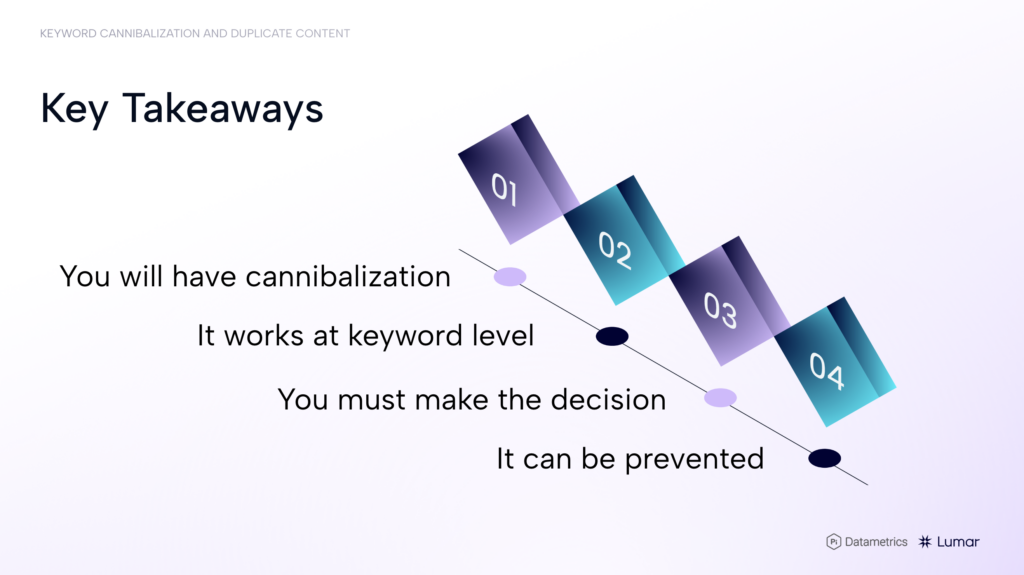

Meet the SEO Experts
- Jon Earnshaw, Chief Product Evangelist, Pi Datametrics
- Richard Barrett, Director of SEO Professional Services, Lumar
- Matt Hill, SEO Solutions Engineer, Lumar
Don’t miss the next Lumar webinar!
Sign up for our newsletter below to get alerted about upcoming webinars, or give us a follow on LinkedIn or Twitter/X.
Want even more on-demand SEO webinars? Explore the full library of Lumar SEO webinar content.








